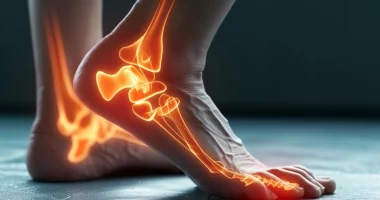Congenital pseudarthrosis of the tibia (CPT)
General Information
Tibial pseudarthrosis (CPT) is an extremely rare condition characterized by a specific bending of the tibia. It contributes to the fracture of the limb and the formation of a pseudoarthritic joint. Congenital tibial pseudarthrosis can develop before birth or occur later in a child’s life. The condition is estimated to occur in 1 in 190,000 people. Congenital pseudarthrosis of the tibia is often associated with neurofibromatosis type 1 (NF1), and nearly half of patients have neurofibromatosis at the same time. Early diagnosis is essential for this disease. The older the child is, the more intractable the symptoms of tibial pseudarthrosis are; in addition, the risk of treatment being ineffective increases. Among other things, it can lead to the need for amputation of the limb. It is a congenital bone disease that causes fusion problems in the lower part of the tibia’s bones. The bones do not touch normally, and there is an artificial articulation between them called pseudarthrosis.
This condition can cause problems such as difficulty walking, short legs, lower limb deformities, and pain. Congenital tibial pseudarthrosis is usually an inherited condition and is more common in individuals with a family history.
Treatment usually requires surgery, and surgery is usually performed using grafts, metal plates, or nails to ensure the bones are connected. The treatment process can be long and complicated, but successful outcomes are possible.
Symptoms of pseudarthrosis in children
Congenital pseudarthrosis is usually detected after the child stands on its feet and tries to walk. In most cases, the bones of the lower limbs are affected: femur or tibia. Acquired form is diagnosed after removing the cast and increasing the load on the limb.
The classic symptoms of a false joint in children are:
- bump-like deformity in the area of the fracture;
- abnormal mobility;
- impaired limb function;
- sensation of numbness in the affected arm or leg.
With untimely treatment of pathology, the muscles begin to atrophy.
Diagnosis of false joint in children
Pseudarthrosis is diagnosed by a pediatric orthopedic traumatologist. The doctor begins by collecting complaints and anamnesis, then examines the limb. Radiography is performed in two (straight and lateral) projections to confirm the diagnosis. In some cases, radiographs are made in additive (oblique) projections. The images reveal the absence of bone callus, smoothing and rounding of the ends of bone fragments, and the appearance of a closure plate at the ends of the fragments (closure of the cavity in the center of the tubular bone). The radiograph of an atrophic false joint shows a conical narrowing of the ends of bone fragments, while the image of a hypertrophic false joint shows thickening of the ends of the fragments and irregular contours of the gap. In a false joint, the end of one fragment becomes convex and the other concave.
Genetic testing may be ordered in some cases to determine the genetic nature of the disease.
Treatment of tibial pseudarthrosis
Pseudarthrosis of the tibia is a severe condition that requires treatment. Before the fracture, it consists of immobilizing the limb with an orthosis (knee and hip brace); surgical treatment is required after the fracture.
How is congenital tibial pseudarthrosis treated?
Treatment usually requires surgical intervention. Treatment usually involves the following steps:
- Bone graft. During surgery, a bone graft from a patient or donor may be used to help fuse the patient’s bones together. The graft is placed in the bone junction area of the tibia, and a suitable environment is created for the bone to grow.
- Hollow nail. In this method, a hollow nail is inserted where the tibia bones join. This nail stimulates the growth of the surrounding bone tissue, helping the bones to fuse.
- Metal plates. During surgery, metal plates may be used to join bones together. These plates stimulate bone growth in the area where the bones are joined.
- Distraction osteogenesis. This treatment method aims to slowly retract the bones and form new bone tissue between them. This method helps the tibia bones to fuse together, promoting bone growth.
The treatment process can vary depending on the patient’s condition and treatment method. Surgical intervention is often complex and requires a long rehabilitation process. However, the right choice of treatment method can significantly impact a patient’s health and mobility.
All these treatment options are available in more than 460 hospitals worldwide (https://doctor.global/results/diseases/congenital-pseudarthrosis-of-the-tibia-cpt). For example, Surgical treatment of congenital pseudarthrosis of the tibia can be done in 29 clinics across Turkey for an approximate price of $17.5 K(https://doctor.global/results/asia/turkey/all-cities/all-specializations/procedures/surgical-treatment-of-congenital-pseudarthrosis-of-the-tibia).
The healing process of congenital tibial pseudarthrosis
Because surgery is usually required, the recovery process can be long and challenging. The recovery process can vary depending on the patient’s age, general health, type of surgery, and treatment method. However, it usually involves the following steps:
Postoperative period
Walking is restricted until the patient’s leg wounds have completely healed. This process usually takes 4-6 weeks, and patients are advised to support their legs with a high pillow.
Physiotherapy
After surgery, patients receive physical therapy. This includes special exercises, massage, and other procedures to speedup bone healing and increase mobility. The process can take 6 to 12 months.
Controls
After surgery, patients are regularly checked by their doctors. During these check-ups, the bone joining process is monitored, and the treatment plan is changed if necessary.
Transition to an active life
Once the recovery process is complete, patients can return to normal activities. However, because it is long, patients are advised to avoid particularly strenuous activities.


